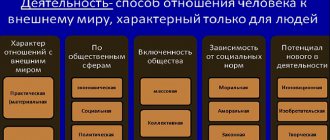Updated July 24, 2021 806 Author: Dmitry Petrov
Hello, dear readers of the KtoNaNovenkogo.ru blog. Homo sapiens cannot exist without activity. Thanks to it, the formation and development of personality occurs, recognition of one’s needs and their satisfaction.
Such activity contributes to the development and improvement of all humanity. What is activity, what does it consist of and what types of it exist, you will learn from this article.
Definition of activity - what is it?
Synonyms for the word “activity” are words such as: labor, action, business, work, that is, it represents any type of activity that has meaning and is therefore conscious.
This is a process in which two parties always interact: subject and object. The first is the one who actually does something (he is also called the doer). The object, in turn, is what the actions of the subject are directed towards with a specific purpose.
In philosophy, this term represents a spiritual form: after all, in order to do something, we need will (what is it?), which is one of the components of the spirit. The will is based on the values that a person strives to achieve through actions.
If you love beauty, then create art, if you want true knowledge, go to science, economic activity brings benefits to society, and those seeking justice promote morality (what is this?).
For a deeper understanding of the term, you need to know :
- activity is what transforms the world around us. If animals simply adapt to almost any conditions, then man strives to improve the environment in which he finds himself;
- activity is always connected with creativity, since only by going beyond the boundaries of the known and familiar, we are able to create something new.
Just above is a video that examines in detail the issue of human activity within the framework of the school social studies .
A very clear and short story. I highly recommend listening.
conclusions
Scientific and technological progress is rapidly changing the picture of reality familiar to many, affecting all areas of human activity - some of its varieties are consigned to history, others are replacing them. Nowadays, information activities are gaining more and more importance in the world, in which very substantial funds are invested annually, while funding for a number of other professions is steadily declining. At the same time, the usefulness and significance of various areas of information activity are not the same. Thus, activities aimed at making public and disseminating new knowledge bring enormous benefits to society, while advertising activities set purely commercial goals designed to increase sales of a particular product and increase the profits of its manufacturers. Consequently, any activity that is truly useful to society is adjacent to another activity that is beneficial only to certain people or companies.
Types of human activities
All types are divided according to the method of implementation into material (practical) and spiritual.
- The practical form includes the transformation of the material, material world (nature and society). For example, the production of goods or construction. Practical activities are divided into: Material and production - the object is nature, and the result is material goods.
- Socially transformative - the object is society, and the result is a change in social relations.
Its subspecies include:
- Cognitive activity, the result of which is knowledge.
Value-oriented, as a result of which a person’s worldview is formed.
These types are interconnected (practical and spiritual).
For example, the results of spiritual activity (music, scientific achievements) are captured using a practical form (printing notes, publishing books). Well, the practical form, in turn, is impossible without the spiritual (idea).
Another classification of activities is based on the ways of forming a person as an individual. Psychologists have identified several types of activities.
- Gaming – the leading activity in children, there is no goal as such (the process itself is important), is a way of understanding the world. In the game, through imitation of reality, knowledge of the environment is carried out. It is conditional in nature (imaginary situations are played out), but certain rules and norms are followed.
This is the only type of activity that is characteristic not only of people, but also of animals. - Academic – acquiring skills and discovering abilities that will help you live a happier, more comfortable and successful life. Studying may not always be purposeful. Often a person acquires knowledge spontaneously (from TV, movies, books, the Internet). The student does not create new knowledge, but only masters existing knowledge.
- Labor is the interaction of a person with the outside world, aimed at creating a socially useful product (material and spiritual) that helps improve the standard of living of society.
The components of labor are the knowledge and skills of a person, as well as his skill. Work is carried out out of necessity, but at the same time transforms the world around us. It is aimed at obtaining a socially useful result, in contrast to a game in which the main thing is the process. - Communication activities are aimed at the exchange of information, emotions, feelings, assessments and specific actions.
The peculiarity is that it requires a partner (an equal subject of communication) and the use of speech (language). Communication helps a person become an individual, develop communication skills, express himself, gain new knowledge (this type is present in all others). - Creative – any type of activity that leads to a unique result (the creation of something qualitatively new).
It is distinguished by uniqueness, originality and uniqueness of ideas. Important components for creativity are intuition (anticipation of the result), imagination and fantasy. Creativity is included in almost all types of human activity, as well as communication.
Communication
Communication is a specialized form of activity, since, firstly, it accompanies a person throughout his life. Secondly, the information received influences the beliefs, attitudes and ultimately the behavior of individuals.
According to the methods of communication, it is permissible to divide into the following types:
- direct - using the senses, vocal cords and hands;
- indirect – tools created by people (telephone, Internet, etc.) and the media are used;
- direct – people communicate directly with each other;
- indirect - there are intermediaries between subjects, for example, a teacher, through a child, conveyed a request to parents - to come to school for a meeting.
Based on the subjects of communication, the following types of interaction are distinguished:
- two real people;
- an individual and an object to which human properties are attributed, for example, pets, toys;
- internal dialogue;
- communication between several fictional characters, for example, in literary works.
Human needs
It is said above that activity is a conscious process endowed with meaning. That is, if you do something, you understand why you need it . How is meaning born? Initially, you realize that you need something.
For example, your stomach growls, you realize a need - hunger - and go to the kitchen to prepare food for yourself. If you did not understand your feelings, and specifically, did not recognize the feeling of hunger, then no further action would have followed.
Thus, a need is a need for something.
There are many classifications of this phenomenon, but the most frequently used is “Abraham Maslow’s pyramid of needs” (American behavioral psychologist).
Studying human behavior, he came to the conclusion that in addition to short-term needs (buying a car), which change throughout life, there are basic needs . The latter represent the basis of a happy existence, provided they are satisfied.
- Physiological - the simplest, but vital needs - sleep, food, air, clothing, etc. This is the very first, primitive level (this is how newborns live).
- The need for security is necessary for mental peace, because only then can we develop effectively and feel comfortable (the parents are called upon to provide this need to the child).
- Social needs are variously expressed desires to be with people, to feel part of a family, class, group, country, to belong to people like me. A person cannot live and develop outside of society (adolescents).
- Esteem Need – We want to be leaders, valued members of society, loved and appreciated (by adults).
- The need for self-actualization or self-expression is the highest level of needs, which not everyone achieves. Here the individual needs creative development, dissemination of his skills and knowledge, thus expressing his inner “I” (mature people).
A little later, Maslow supplemented his classification with three more types of needs: cognitive (the desire to explore, discover), aesthetic (the desire for harmony and beauty) and transcendental (the selfless transfer of one’s own experience for the purpose of self-improvement of other people).
Ability Levels
Each person has a set of individual abilities. But for everyone they are developed at a different level. These include: inclinations, abilities, giftedness, talent, genius. Let's look at them in more detail:
- Inclinations are prerequisites for the development of abilities, based on natural predisposition. For example, a girl has a good voice that can be developed to an operatic level, but she has not reached her potential;
- Abilities – compliance of skills and knowledge with the requirements of the activity performed. For example, an accountant accurately records income and expenses;
- Giftedness is the ability to achieve high results in a specific activity. For example, a sales representative closes more than fifty percent of a company's deals;
- Talent is the ability to become outstanding in a certain field. For example, the paintings of a young artist are of high quality and are in demand;
- Genius is the highest degree of development of talent. For example, Mozart had exceptional skills from early childhood and was able to maximize them.
Ability levels are determined by a person's contribution to their development.
Geniuses influence society as a whole and leave a mark on history. Their work changes the course of human historical development. This highest degree of human abilities is characteristic of only a few.
Motive of human activity
After realizing the need, a motive for activity appears - this is an internal urge to achieve what you want. It is formed by additional factors: traditions (what is it?), beliefs, attitudes, interests, and so on.
For example, a girl with the conviction that she must get married devotes the lion's share of her time to searching for a groom. That is, the need for marriage (to have a family, to be a member of it) becomes the motive for her activity.
Reflection of social activities in scientific literature
Science studies activity, considering it one of the fundamental tasks. Great minds in the field of philosophy and sociology, deeply imbued with natural science and social science, are struggling with this problem.
In an effort to classify social activity according to its characteristics, scientists offer various options.
For example, M. S. Kvetnoy describes division into four elements:
- interests and needs;
- goals and motives;
- means and actions;
- products.
M. S. Kagan is based on three main elements of social activity, but in a different context:
- subject;
- an object;
- activity.
According to B. A. Grushin, there are also three classification series that need to be distinguished.
- by the nature of the energy expended (muscular, mental, mental strength);
- by composition (subject activity, informational and “play of physical or mental forces”);
- by general nature (production, consumption, communication).
Target
When internal motivation takes place, we begin to build an image in our head of what we want to achieve in the end. A girl who wants to get married begins to think about what her future husband should be like: age, eye color, social status, nationality, appearance, etc. Thus, she paints for herself a clear picture of what she actually needs to strive for.
Goal setting is an integral part of human activity.
We first create something in our minds, then we try to bring it to life. Animals, unlike us, are guided only by instincts: they do not think about what, how and why they do something. When choosing a female, a wolf does not walk through the forest for 3 years looking for a she-wolf with the most beautiful fur, but a person is quite capable of this.
Maybe this is our happiness - we can choose and adjust our goals.
Labor activity is for adults
The currently known forms of division of labor are:
- general (all social production consists of different spheres: industry, transport, communications, agricultural sector and others);
- private (the emergence of relatively independent industries within the spheres of the general division of labor);
- unit (the way labor is divided in each specific enterprise).
All three forms are connected by strong bonds. Both general and individual forms of division of labor can influence private ones. All three are affected by technical progress, which poses new technological and organizational challenges and changes the characteristics of the activities of participants in the production process.
This happens, for example, due to production automation. It liberates workers, leads to a different division of labor than before and changes the general structure of workers.
Means to achieve the goal
So, I see the goal. I'm going to see her. At this stage we choose the means to achieve what we want. By means here we mean anything - anything that will help you achieve your goal. If you want to become a good cook, you will have to graduate from culinary school, gain experience, and constantly improve your skills by learning new skills.
It is important to know: firstly, the means and the end must be proportionate . For example, you want to make money, you open a personal business (flower shop), but in the end your enterprise operates at a loss. A reasonable person understands that in this way he will never improve his well-being and will try something else - the means will not justify the end.
Secondly, the means must be in the moral category . If this is not so, then all human activity is immoral. Violating the law, lying to achieve personal gain, betraying loved ones for the sake of your goal is immoral. In this case, the end does not justify the means.
Self-test questions
1. What is an activity? 2. What features are inherent in human activity? 3. How are activities and needs related? 4. What is the motive of activity? How is a motive different from a goal? What is the role of motives in human activity? 5. Define the need. Name the main groups of human needs and give specific examples. 6. What can be attributed to the results (products) of human activity? 7. Name the types of human activities. Explain their diversity using specific examples. 8. How are activity and consciousness related?
Action
An action is a single element of activity.
The latter consists of a set of small steps interconnected. For example, to build a house, you first need to dig a foundation, build walls and a roof, and pour the floor.
Sociologist M. Weber identified 4 types of social actions :
- goal-oriented – striving to achieve a reasonable goal (preparing a speech before a speech);
- value-rational – focused on moral values (a soldier’s refusal to give up his country’s military secrets);
- affective - actions committed under the influence of feelings and emotions (a person in a rage can break something);
- traditional - habitual actions, rituals, customs (throwing a wedding bouquet into a crowd of bridesmaids, fireworks for the New Year);
The first two types underlie activity, the second two appear partially and are of an auxiliary nature.
Elements, manifestations and methods of implementation
The characteristics of activity also include the concepts of “action,” “behavior,” and “operation.”
The element of activity is action. This is an action that has a pronounced social meaning.
Mental activity is externally manifested in behavior. This is either a certain facial expression and posture of an individual, or a series of actions performed. Here it is not always possible to observe the presence of a definite plan or goal.
An operation is a special way of performing some action under certain conditions. With their help, the main tasks are solved. In most cases, operations are automated, often unconscious.











